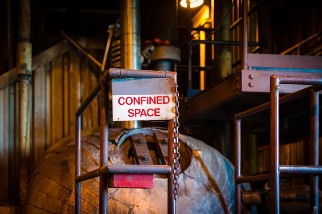
When working in confined spaces, an important question for safety professionals to consider is what to do if someone becomes injured, incapacitated or trapped in a space and has to be rescued.
The steps below will help guide you through preparing for and executing a confined space rescue in a timely manner.
1. Conduct Rescue Drills
One of the best ways to prepare is to practice. There are many theories about the best practices for confined space rescue and rescue drills allow OSH professionals to put those theories to the test.
Rescue drills provide personnel the experience of working through different scenarios in order to familiarize themselves with situations they could encounter in confined spaces. Conducting rescue drills helps prepare teams for working in confined spaces, and when necessary, rescuing coworkers.
2. Understand That Rescues Fall Into Two Categories
There are time-sensitive and non-time-sensitive rescues. Time-sensitive or “emergency” rescues typically involve oxygen-deficient atmospheres where there is a small window of time, typically six minutes, to get someone out.
An example of a non-time-sensitive rescue would be a situation in which someone falls and breaks an ankle going into a confined space. In these types of circumstances there are sufficient O2 levels and, therefore, the rescue is not as time-sensitive and can be conducted without the use of supplemental oxygen.
Understanding both types of rescues helps safety professionals develop strategies for implementing and executing an appropriate response.
3. Make Every Entrant Wear a Full Body Harness
Of all the equipment involved in confined space rescue, perhaps the most important is the full body harness. Many rescues require lifting equipment to remove a person from a confined space, and that lifting equipment will need to attach to a full body harness.
The harness plays an important role in both vertical rescues to help lift a worker out of a space, and horizontal rescues to help place the worker on a stretcher or rescue board.
Without a full body harness, rescues can become much more difficult and time-consuming. Workers do not want to have to place a full body harness on an inert body, particularly if it is a time-sensitive rescue.
4. Survey Confined Spaces for Rescue
Rescuing someone in a timely manner requires an in-depth knowledge of the parameters of the confined space. Depending on the configuration and location of a space, the OSH professional may need to adjust the rescue strategy.
In the chemical industry for instance, the traditional tripod used to lift workers out may not be feasible in all confined spaces. As such, anchor eyebolts may need to be installed over the confined space entry points for vertical rescues. Surveying beforehand will help determine the proper tools and techniques for working within a confined space, and getting someone out in a rescue situation.
5. Survey Openings
Along with surveying confined spaces, it’s also important to survey and assess openings. Some may think that a rescue person with a self-contained breathing apparatus (SCBA) can fit into any confined space, and/or be able to move freely within it. In many instances, that is not the case.
Surveying openings provides an assessment of how much room workers and/or rescuers will have to enter a confined space, and what types of equipment they will be able to bring with them.
6. Meet With Local Authorities About Rescue Capabilities
It is important to remember that it is not always possible to rely on 9-1-1 for a confined space rescue solution. Depending on the situation, authorities may not have the manpower or capability to perform a rescue.
Understanding the capabilities of local authorities helps safety professionals develop rescue plans suited to each particular situation. If local authorities are not able to assist, the OSH professional must adjust accordingly to ensure that the proper personnel are in place to respond to an emergency.
7. Have a Rescue Team
In many rescue situations, workers think that they can hook a person up to the line on the rescue winch and don’t need a rescue team. While this strategy might work in situations where someone goes straight to the bottom of a confined space and does not move, those types of incidents are rare. Furthermore, if there is more than one entrant, that strategy is not feasible.
Safety professionals need to ensure that they have fully equipped and trained confined space rescue team (CSRT) ready to respond in an emergency situation. Regardless of the confined space or opening, a rescue team needs to be prepared and ready to respond in a timely manner if someone is injured, trapped or incapacitated.
CSRTs could be qualified members of an employer’s own team, local emergency response or an outside contractor. The team’s makeup will depend on several factors including budget, local resources and the availability of qualified personnel.
ANSI/ASSP Z117.1 provides minimum safety requirements for entering, exiting and working in confined spaces at ambient atmospheric temperature. The purpose of Z117.1 is to establish minimum requirements and procedures for the safety and health of employees who work in and in connection with confined spaces.
Understanding Risk Management and Assessment
We have the resources and expert guidance you need to improve how you assess risks to prevent hazards, protect workers and safeguard equipment.
Learn more